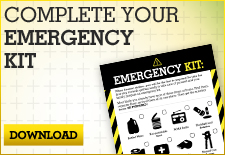
Disasters can happen… at any time. Be prepared to take action before, during and after.
School & Workplace Violence
A violent incident can occur at your work or school under a variety of circumstances, so no one set of guidelines is able to cover specific actions to take in every situation. Even so, familiarity with the following information can help with planning your own survival strategy in a variety of circumstances. School and workplace violence may take the form of an active shooter. An active shooter is a person who is using a firearm or other weapon with the intent to injure or kill others. Law enforcement personnel will deploy to the location of the active shooter with the primary goal of stopping the shooter.
During an emergency at your school or workplace resulting from violence or any other type of emergency, you may receive information via automated text alerts or phone messages, over a public announcement system or police radio speakers. If you have phone service or internet, you can try to pass on and receive real time information through 9‐1‐1.
Before
Alert Lockdown Inform Counter Escape (ALICE) is a principle you, your family, and your workplace can utilize in order to increase your chances of surviving violence at your school or workplace. It is important to remember that the “ALICE” principle is not a fixed set of actions you have to take when confronted with an incident ‐ you can decide the appropriate actions to take and tailor the steps based on the situation you find yourself in.
2 – Complete the Emergency Contacts Card and place one in your Emergency Kit.
3 – Prepare an Emergency Kit. The Emergency Kit should be easily accessible should you and your family be forced to shelter in place (stay at home) for a period of time.
Lockdown‐ This is a semi‐secure starting point from which you will make survival decisions. If you decide not to evacuate, secure the room by locking and barricading the door. Look for alternate escape routes, and call 911. Move away from the doorway and place phones on silent. Once the door is secure, do not open it for anyone and prepare to defend yourself and others should an assailant come into the room.
Inform‐ Using any means necessary to pass on real time information. Provide information in plain language, including important items like who, what, where, when and why.
Counter‐ This is the use of simple, proactive techniques should you be confronted by an armed assailant or threatening situation. Know that anything can be a weapon, and throwing items can distract the person or their aim. If necessary, attack in a group and grab the individual’s limbs and head to hold them to the ground. Noise in the room can also distract an assailant. If you have control of the attacker, call 911 and tell the police your location.
Escape‐ Remove yourself from the danger zone as quickly as possible. If you can evacuate by window, break out the glass and clear as much glass as possible from the frame. Consider using belts or other items as improvised rope. If you can evacuate, run in a zigzag pattern as fast as you can and do not stop running until you are far away from the area. Contact 911 as soon as you are in a safe location to let them know of the situation.
During
If a violent act happens at your school or place of work, specifically one that involves an active shooter, it is important to know how to stay safe.
- Proceed to a room that can be locked. On your way to the room, tell as many people as possible to do the same.
- Lock all doors and windows and turn off the lights.
- Have one person in the room call 911 and be prepared to advise the dispatcher of your location, name, the number of people in the room with you, any and all information about the person’s actions and location.
- Remain in the room until advised by law enforcement personnel to exit the building. Do not respond to unidentified or unrecognized voice commands or fire alarms.
- Officers will enter your building and check each room. If you have not been contacted within one hour, call 911 for further instructions.
- Determine if the room you are in or near can be locked or otherwise secured. If so, follow the procedures as indicated above.
- If the room can’t be locked or secured, locate the nearest exit and determine whether or not you can exit the building safely.
- If you can safely leave the building, do so.
- Try to remain calm and call 911 if possible. If you are unable to speak, leave the phone line open so that the dispatcher can hear what is taking place.
- If you cannot escape or hide, you may try to negotiate with the person, pretend to be unconscious, or fight and attempt to overpower the person with force, as a last result.
- Police officers responding to an active shooter may be wearing regular uniforms or special tactical gear, but they will be clearly identified as law enforcement officers.
- Responding officers will point firearms at you while seeking the threat. This is a normal part of their training and response. Avoid any sudden furtive movements and obey all officer commands. Keep your hands visible to officers at all times.
- Responding officers are trained to proceed immediately to the area where shooting is taking place to neutralize the threat. If you are injured, they will not stop to assist you.
- Another group of officers and/or tactical medics will follow to provide medical assistance and help with evacuation.
- Remain calm and immediately comply with all commands from law enforcement officers.
After
Once you have escaped to a safe location, keep in mind that the entire building, whether a school or workplace, is still a crime scene. Police and emergency personnel will typically not let anyone leave until the situation is fully under control and all witness have been identified and questioned. Remain at whatever assembly point authorities designate until you are released. Always obey the commands of law enforcement during an active shooter or workplace violence event.
Back to top



